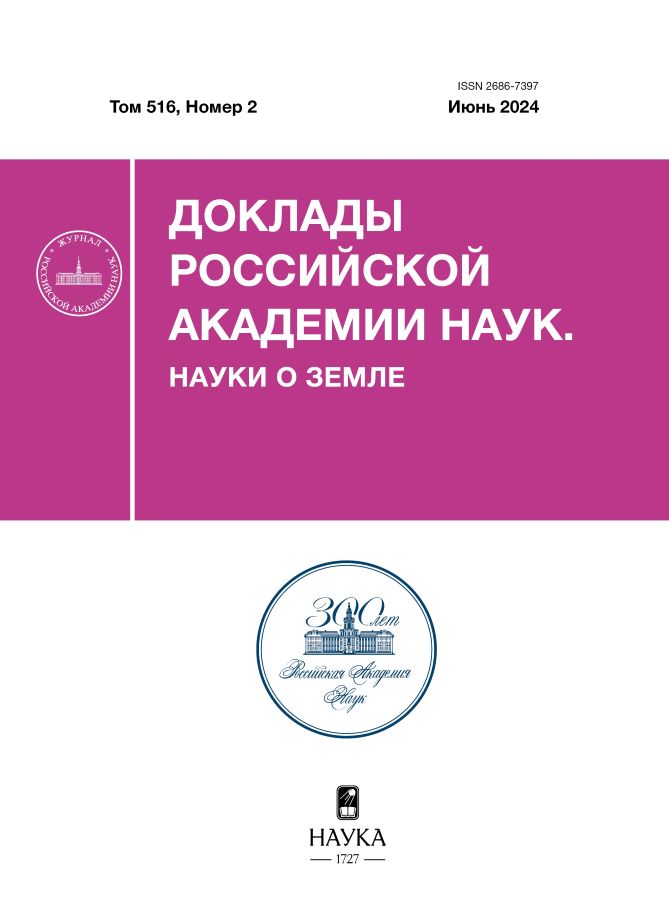Lithospheric structure of the Sarmatia north-eastern part based on new seismological data
- Autores: Adushkin V.V.1, Goev A.G.1, Vinogradov Y.A.2, Shapovalov A.V.1
-
Afiliações:
- Sadovskiy Institute of Geosphere Dynamics, Russian Academy of Sciences
- Geophysical Survey, Russian Academy of Sciences
- Edição: Volume 516, Nº 2 (2024)
- Páginas: 616-621
- Seção: GEODYNAMICS
- ##submission.dateSubmitted##: 31.01.2025
- ##submission.datePublished##: 12.12.2024
- URL: https://ter-arkhiv.ru/2686-7397/article/view/650050
- DOI: https://doi.org/10.31857/S2686739724060142
- ID: 650050
Citar
Texto integral
Resumo
For the first time, based on the receiver function technique, lithospheric velocity models of the Khoper block and the Losevskaya suture zone was obtained. Mentioned structures belongs to the Voronezh crystalline massif of the Sarmatia protocraton. The crust is defined by a four-layer structure with the presence of a waveguide in the lower crust. For the Khoper block of Sarmatia, the presence and characteristics of low velocity zone in the upper mantle at depths of 110–150 km, marking mid-lithospheric discontinuity (MLD), have been identified and determined. A complex, possibly gradient, structure of the crust-mantle transition has been revealed.
Palavras-chave
Texto integral
Sobre autores
V. Adushkin
Sadovskiy Institute of Geosphere Dynamics, Russian Academy of Sciences
Email: goev@idg.ras.ru
Academician of the RAS
Rússia, MoscowA. Goev
Sadovskiy Institute of Geosphere Dynamics, Russian Academy of Sciences
Autor responsável pela correspondência
Email: goev@idg.ras.ru
Rússia, Moscow
Yu. Vinogradov
Geophysical Survey, Russian Academy of Sciences
Email: goev@idg.ras.ru
Rússia, Obninsk
A. Shapovalov
Sadovskiy Institute of Geosphere Dynamics, Russian Academy of Sciences
Email: goev@idg.ras.ru
Rússia, Moscow
Bibliografia
- Bogdanova S. V., Gorbatschev R., Garetsky R. G. Europe/East European Craton / In: Reference Module in Earth Systems and Environmental Sciences. Elsevier. 2016. P. 1–18.
- Семенов А. Е. Характер сейсмичности Техногенно-нагруженной лискинской сейсмически активной зоны Воронежского кристаллического массива. Российский фонд фундаментальных исследований, М., 2022. С. 118–125.
- Долбилова Е. С. Пространственный анализ петроплотностной и петромагнитной карт Хоперского мегаблока Воронежского кристаллического массива / Материалы ежегодной молодежной научной конференции кафедры геофизики Воронежского государственного университета. Воронеж, 2022. С. 37–39.
- Литосфера воронежского кристаллического массива по геофизическим и петрофизическим данным / Гл. ред. член-корр. РАН Н. М. Чернышов, Воронеж, 2012. 330 с.
- Лебедев И. П., Молотков С. П., Кривцов И. И., Лосицкий В. И. Структурно-геологические особенности воронцовской серии Воронежского кристаллического массива // Вестник Воронежского госуниверситета. Серия геол. 1999. № 7. С. 25–31.
- Окончательный отчет по теме 34-94-51/1 “Изучение особенностей геологического строения и металлогении Воронежского кристаллического массива с целью составления прогнозно-металлогенических карт м-ба 1:500 000 за 1991–1999 гг.”. Отв. исп. Лосицкий В.И., Молотков С.П. Воронеж, 1999.
- Винник Л. П. Сейсмология приемных функций // Физика Земли. 2019. № 1. С. 16–27.
- Dziewonski A. M., Chou T. A., Woodhouse J. H. Determination of earthquake source parameters from waveform data for studies of global and regional seismicity // J. Geophys. Res. 1981. V. 86. Р. 2825–2852.
- Ekström G., Nettles M., Dziewonski A. M. The global CMT project 2004-2010: Centroid-moment tensors for 13,017 earthquakes // Physics of the Earth and Planetary Interiors. 2012. V. 200–201. Р. 1–9.
- Kennett B. L. N., Engdahl E. R. Traveltimes for global earthquake location and phase identification // Geophys. J. Int. 1991. V. 105. P. 429–465.
- Алешин И. М. Построение решения обратной задачи по ансамблю моделей на примере инверсии приемных функций // Докл. РАН. Науки о Земле. 2021. Т. 496. № 1. С. 63–66.
- Press W. H., Teukolsky S. A., Vetterling W. T., Flannery B. P. Numerical Recipes 3rd Edition: The Art of Scientific Computing. New York: Cambridge University Press, 2007.
- Трегуб А. И., Надежка Л. И., Ежова И. Т. Корреляционная модель основных границ в разрезе литосферы присводовой части Воронежской антеклизы // Вестник Воронежского государственного университета. Серия: Геология. 2018. № 1. С. 121–126.
- Yang H., Artemieva I. M., Thybo H. The mid-lithospheric discontinuity caused by channel flowin proto-cratonic mantle // J. of Geophys. Res. Solid Earth. 2023. V. 128. № 4. e2022JB026202.
- Wang Z., Kusky T. The importance of a weak mid-lithospheric layer on the evolution of the cratonic lithosphere // Earth-Science Reviews. 2019. V. 190. P. 557–569. https://doi.org/10.1016/j.earscirev.2019.02.010.
- Fu H.-Y., Li Z.-H., Chen L. Continental mid-lithosphere discontinuity: A water collector during craton evolution // Geophysical Research Letters. 2022. V. 49. e2022GL101569. https://doi.org/10.1029/2022GL101569
- Гоев А. Г., Санина И. А., Константиновская Н. Л. Особенности глубинного скоростного строения коллизионной зоны центральной части ВЕП по данным станций “Михнево” и “Обнинск” // Динамические процессы в геосферах. 2021. № 13. С. 81–89.
Arquivos suplementares













